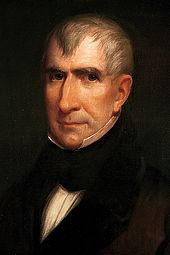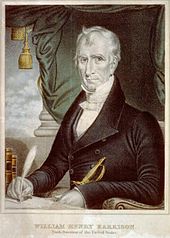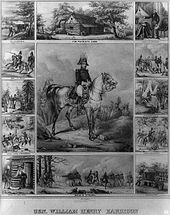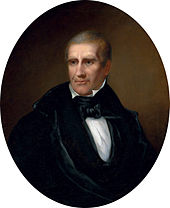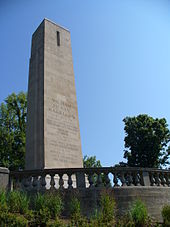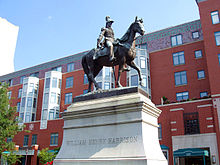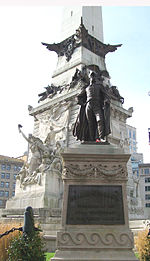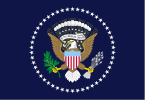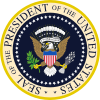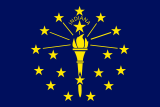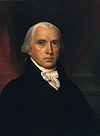- William Henry Harrison
-
For other people named William Harrison, see William Harrison (disambiguation).
William Henry Harrison 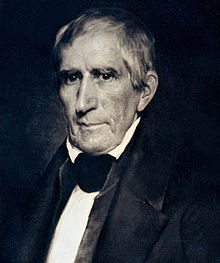
Harrison in a copy of an 1841 daguerreotype portrait by Moore and Ward - the first photograph ever taken of a U.S. President 9th President of the United States In office
March 4, 1841 – April 4, 1841Vice President John Tyler Preceded by Martin Van Buren Succeeded by John Tyler United States Ambassador to Colombia In office
May 24, 1828 – September 26, 1829Nominated by John Quincy Adams Preceded by Beaufort Watts Succeeded by Thomas Moore United States Senator
from OhioIn office
March 4, 1825 – May 20, 1828Preceded by Ethan Brown Succeeded by Jacob Burnet Member of the U.S. House of Representatives
from Ohio's 1st districtIn office
October 8, 1816 – March 3, 1819Preceded by John McLean Succeeded by Thomas Ross Governor of the District of Louisiana In office
October 1, 1804 – July 4, 1805Preceded by Amos Stoddard (Acting) Succeeded by James Wilkinson Governor of Indiana In office
January 10, 1801 – December 28, 1812Preceded by Position established Succeeded by John Gibson (Acting) Secretary of Northwest Territory In office
June 28, 1798 – October 1, 1799Governor Arthur St. Clair
Charles ByrdPreceded by Winthrop Sargent Succeeded by Charles Byrd Member of the U.S. House of Representatives
from the Northwest Territory's At-large districtIn office
March 4, 1799 – May 14, 1800Preceded by Constituency established Succeeded by Paul Fearing Personal details Born February 9, 1773
Charles City, Virginia ColonyDied April 4, 1841 (aged 68)
Washington, D.C., U.S.Political party Whig Party Spouse(s) Anna Symmes Alma mater Hampden-Sydney College
University of PennsylvaniaProfession Military officer Religion Episcopal Signature 
Military service Allegiance United States Service/branch United States Army
Indiana Territory militiaYears of service 1791–1797
1811
1812–1814Rank Lieutenant (Army)
Major general (Militia)Unit Legion of the United States Commands Army of the Northwest Battles/wars Northwest Indian War
• Siege of Fort Recovery
• Battle of Fallen Timbers
Tecumseh's War
• Battle of Tippecanoe
War of 1812
• Siege of Fort Wayne
• Battle of the ThamesWilliam Henry Harrison (February 9, 1773 – April 4, 1841) was the ninth President of the United States (1841), an American military officer and politician, and the first president to die in office. He was 68 years, 23 days old when elected, the oldest president elected until Ronald Reagan in 1980, and last President to be born before the United States Declaration of Independence. Harrison died on his 32nd day in office[1] of complications from pneumonia, serving the shortest tenure in United States presidential history. His death sparked a brief constitutional crisis, but that crisis ultimately resolved many questions about presidential succession left unanswered by the Constitution until passage of the 25th Amendment.
Before election as president, Harrison served as the first territorial congressional delegate from the Northwest Territory, governor of the Indiana Territory and later as a U.S. representative and senator from Ohio. He originally gained national fame for leading U.S. forces against American Indians at the Battle of Tippecanoe in 1811[2], where he earned the nickname "Tippecanoe" (or "Old Tippecanoe"). As a general in the subsequent War of 1812, his most notable contribution was a victory at the Battle of the Thames in 1813, which brought an end to hostilities in his region.
After the war, Harrison moved to Ohio, where he was elected to the United States Congress, and in 1824 he became a member of the Senate. There he served a truncated term before being appointed as Minister Plenipotentiary to Colombia in May 1828. In Colombia, he spoke with Simon Bolívar about the finer points of democracy before returning to his farm in Ohio, where he lived in relative retirement until he was nominated for the presidency in 1836. Defeated, he retired again to his farm before being elected president in 1840.
Contents
Early life
Early life and education
William Henry Harrison was born February 9, 1773, the youngest of Benjamin Harrison V and Elizabeth Bassett's seven children. They were a prominent political family who lived on Berkeley Plantation in Charles City County, Virginia.[3] He was the last president born as a British subject before American Independence. His father was a planter and a delegate to the Continental Congress (1774–1777) who signed the Declaration of Independence. He was governor of Virginia between 1781 and 1784.[4] William's older brother Carter Bassett Harrison was elected a representative of Virginia in the United States House of Representatives.[3]
In 1787, at the age of 14, Harrison entered the Presbyterian Hampden-Sydney College.[5] He attended the school until 1790, becoming well-versed in Latin and basic French. He was removed by his Episcopalian father, possibly because of a religious revival occurring at the school. He then briefly attended an academy in Southampton County. He allegedly became involved with the antislavery Quakers and Methodists at the school.
Angered, his pro-slavery father had him transfer to Philadelphia, where he boarded with Robert Morris, probably because of medical training available there. Harrison entered the University of Pennsylvania in 1790, where he continued to study medicine under Dr. Benjamin Rush.[6] As Harrison explained to his biographer, he did not enjoy the subject. Shortly after he had arrived in Philadelphia in 1791, his father died, leaving him without funds for further schooling. Eighteen years old, he was left in the guardianship of Morris.[7]
Early military career
Governor Henry Lee of Virginia, a friend of Harrison's father, learned of Harrison's impoverished situation after his father's death and persuaded him to join the army. Within 24 hours of meeting Lee, Harrison was commissioned as an ensign in the U.S. Army, 11th U.S. Regt. of Infantry at the age of 18. He was first assigned to Cincinnati in the Northwest Territory where the army was engaged in the ongoing Northwest Indian War.[6][8]
General "Mad Anthony" Wayne took command of the western army in 1792 following a disastrous defeat by its previous commander, Arthur St. Clair. Harrison was promoted to lieutenant that summer because of his strict attention to discipline, and the following year he was promoted to serve as aide-de-camp. It was from Wayne that Harrison learned how to successfully command an army on the American frontier. Harrison participated in Wayne's decisive victory at the Battle of Fallen Timbers in 1794, which brought the Northwest Indian War to a successful close for the United States.[9] After the war, Lieutenant Harrison was one of the signatories of the Treaty of Greenville in 1795, which opened much of present-day Ohio to settlement by European Americans.[3][7][10][11]
After the death of his mother in 1793, Harrison inherited a portion of the family's estate, including about 3,000 acres (12 km2) of land and several slaves. Still in the army at the time, Harrison sold his land to his brother.[12]
Marriage and family
In 1795 Harrison met Anna Symmes, of North Bend, Ohio. She was the daughter of Judge John Cleves Symmes, a prominent figure in the state, and former representative to the Congress of the Confederation.[3] When Harrison asked the judge for permission to marry Anna, he was refused. Harrison waited until Symmes left on business, then he and Anna eloped and married on November 25, 1795.[13] Afterward, concerned about Harrison's ability to provide for Anna, Symmes sold the young couple 160 acres (65 ha) of land in North Bend.[14]
Together they had 10 children. Nine lived into adulthood and one died in infancy. Anna was frequently in poor health during the marriage, primarily due to her many pregnancies.[15] Nevertheless, she outlived William by 23 years, dying at age 88 on February 25, 1864.
Political career
Harrison resigned from the army in 1797 and began campaigning among his friends and family for a post in the Northwest Territorial government. With the aid of his close friend, Secretary of State Timothy Pickering, he was recommended to replace the outgoing Secretary of the Northwest Territory. He was appointed to the position, during which time he acted as governor during the frequent absences of Governor Arthur St. Clair.[3][7][16][17]
Member of Congress
Harrison had many friends in the elite eastern social circles, and quickly gained a reputation among them as a frontier leader.[16] Harrison ran a successful horse-breeding enterprise that won him acclaim throughout the Northwest Territory.[18] He championed for lower land prices, the northwesterners' primary concern at the time. The US Congress had legislated a territorial land policy that led to high land costs, a policy disliked by many of the territory's citizens. When Harrison ran for Congress, he campaigned on working to alter the situation to encourage migration to the territory.[19] In 1799, at age 26, Harrison defeated the son of Arthur St. Clair and was elected as the first delegate representing the Northwest Territory in the Sixth United States Congress. He served from March 4, 1799, to May 14, 1800.[3][20] As a delegate from a territory, not a state, he had no authority to vote on bills but was permitted to serve on a committee, submit legislation, and debate.[21]
As delegate, Harrison successfully promoted the passage of the Harrison Land Act. This made it easier for the average settler to buy land in the Northwest Territory by allowing land to be sold in small tracts. The availability of inexpensive land was an important factor in the rapid population growth of the Northwest Territory.[22] Harrison also served on the committee that decided how to divide the Northwest Territory. The committee recommended splitting the territory into two segments, creating the Ohio Territory and the Indiana Territory. The bill, 2 Stat. 58, passed and the two new territories were established in 1800.[23]
Without informing Harrison, President John Adams nominated him to become governor of the new territory, based on his ties to "the west" and seemingly neutral political stances. Harrison was confirmed by the Senate the following day.[24] Caught unaware, Harrison accepted the position only after receiving assurances from the Jeffersonians that he would not be removed from office after they gained power in the upcoming elections.[25] He then resigned from Congress.[26] The Indiana Territory consisted of the future states of Indiana, Illinois, Michigan, Wisconsin and the eastern portion of Minnesota.[27]
Governor
Harrison moved to Vincennes, the capital of the newly established Indiana territory, on January 10, 1801.[26] While in Vincennes, Harrison built a plantation style home he named Grouseland for its many birds. It was one of the first brick structures in the territory. The home, which has been restored and has become a popular modern tourist attraction, served as the center of social and political life in the territory.[15] He also built a second home near Corydon, the second capital, at Harrison Valley.[28]
As governor, Harrison had wide ranging powers in the new territory, including the authority to appoint all territorial officials, and the territorial legislature, and to control the division of the territory into political districts. A primary responsibility was to obtain title to Native American lands. This would allow European-American settlement to expand and increase US population to enable the region to gain statehood.[3] Harrison was eager to expand the territory for personal reasons as well, as his political fortunes were tied to Indiana's rise to statehood. In 1803 President Thomas Jefferson granted Harrison authority to negotiate and conclude treaties with the Indians.
Harrison supervised the development of 13 treaties, through which the territory bought more than 60,000,000 acres (240,000 km2) of land from Native American leaders, including much of present-day southern Indiana. The 1804 Treaty of St. Louis with Quashquame led to the surrender by the Sauk and Meskwaki of much of western Illinois and parts of Missouri. This treaty and loss of lands were greatly resented by many of the Sauk, especially Black Hawk. It was the primary reason the Sauk sided with Great Britain during the War of 1812. Harrison thought the Treaty of Grouseland in 1805 appeased some of the issues for Native Americans, but tensions remained high on the frontier.
The 1809 Treaty of Fort Wayne raised new tensions. Harrison purchased from the Miami tribe, who claimed ownership of the land, more than 2,500,000 acres (10,000 km²) of land inhabited by Shawnee, Kickapoo, Wea, and Piankeshaw peoples. Harrison rushed the process by offering large subsidies to the tribes and their leaders so that he could have the treaty in place before President Jefferson left office and the administration changed.[28][29] The tribes living on the lands were furious and sought to have the treaty overturned but were unsuccessful.
In 1803 Harrison lobbied Congress to repeal Article 6 of the Northwest Ordinance, in order to permit slavery in the Indiana Territory. He claimed it was necessary to make the region more appealing to settlers and would make the territory economically viable.[30] Congress suspended the article for 10 years, during which time the territories covered by the ordinance were granted the right to decide for themselves whether to permit slavery. That year Harrison had the appointed territorial legislature authorize indenturing.[31] He attempted to have slavery legalized outright, in both 1805 and 1807. This caused a significant stir in the territory. When in 1809 the legislature was popularly elected for the first time, Harrison found himself at odds with them as the abolitionist party came to power. They immediately blocked his plans for slavery and repealed the indenturing laws he had passed in 1803.[32][33]
President Thomas Jefferson, the primary author of the Northwest Ordinance, had made a secret compact with James Lemen to defeat the pro-slavery movement led by Harrison. Although a slaveholder, he did not want slavery to expand into the Northwest Territory, as he believed the institution should end. Under the "Jefferson-Lemen compact", Jefferson donated money to Lemen to found churches in Illinois and Indiana to stop the pro-slavery movement. In Indiana the founding of an anti-slavery church led to citizens' signing a petition and organizing politically to defeat Harrison's efforts to legalize slavery. Jefferson and Lemen were both instrumental in defeating Harrison's attempts in 1805 and 1807 to secure approval of slavery in the territory.[34]
Army general
Tecumseh and Tippecanoe
An Indian resistance movement against U.S. expansion had been growing through the leadership of the Shawnee brothers, Tecumseh and Tenskwatawa (The Prophet). The conflict became known as Tecumseh's War. Tenskwatawa convinced the native tribes that they would be protected by the Great Spirit and no harm could befall them if they would rise up against the white settlers. He encouraged resistance by telling the tribes to pay white traders only half of what they owed and to give up all the white man's ways, including their clothing, muskets, and especially whiskey, which was becoming known as evil for American Indians.[35]
In August 1810, Tecumseh led 400 armed warriors down the Wabash River to meet with Harrison in Vincennes. As the warriors were dressed in war paint, their sudden appearance at first frightened the soldiers at Vincennes. The leaders of the group were escorted to Grouseland where they met Harrison. Tecumseh insisted that the Fort Wayne Treaty was illegitimate. He argued that no one tribe could sell land without the approval of the other tribes; he asked Harrison to nullify it and warned that Americans should not attempt to settle the lands sold in the treaty. Tecumseh informed Harrison that he had threatened to kill the chiefs who signed the treaty if they carried out its terms, and that his confederation of tribes was growing rapidly.[36] Harrison said the Miami were the owners of the land and could sell it if they so chose. He rejected Tecumseh's claim that all the Indians formed one nation. He said each tribe could have separate relations with the United States if they chose to. Harrison argued that the Great Spirit would have made all the tribes speak one language if they were to be one nation.[37]
Tecumseh launched an "impassioned rebuttal," but Harrison was unable to understand his language.[37] A Shawnee friendly to Harrison cocked his pistol from the sidelines to alert Harrison that Tecumseh's speech was leading to trouble. Some witnesses reported that Tecumseh was encouraging the warriors to kill Harrison. Many of the warriors began to pull their weapons and Harrison pulled his sword. Since the entire town's population was only 1,000, Tecumseh's warriors could have defeated the entire town. Once the few officers pulled their guns to defend Harrison, the warriors backed down.[37] Chief Winnemac, who was friendly to Harrison, countered Tecumseh's arguments and told the warriors that since they had come in peace, they should return home in peace. Before leaving, Tecumseh informed Harrison that unless the treaty was nullified, he would seek an alliance with the British.[38] After the meeting, Tecumseh journeyed to meet with many of the tribes in the region, hoping to create a confederation to battle the United States.[39]
In 1811, while Tecumseh was traveling, Harrison was authorized by Secretary of War William Eustis to march against the nascent confederation as a show of force. Harrison led an army of more than 1,000 men north to try to intimidate the Shawnee into making peace. Instead, the tribes launched a surprise attack on Harrison's army early on the morning of November 6, in what became known as the Battle of Tippecanoe. Harrison defeated the tribal forces at Prophetstown, next to the Wabash and Tippecanoe Rivers. Harrison was hailed as a national hero and the battle became famous. His troops had greatly outnumbered the attackers, and suffered many more casualties during the battle.[40]
When reporting to Secretary Eustis, Harrison informed him the battle occurred near the Tippecanoe River (which led to its naming), and he feared an imminent reprisal attack. The first dispatch did not make clear which side had won the conflict, and the secretary at first interpreted it as a defeat. The follow-up dispatch made the US victory clear. When no second attack came, the defeat of the Shawnee was more certain. Eustis demanded to know why Harrison had not taken adequate precautions in fortifying his camp against attacks. Harrison countered by saying he had considered the position strong enough. The dispute was the catalyst of a disagreement between Harrison and the Department of War that continued into the War of 1812.[41]
The press did not cover the battle at first, and one Ohio paper misinterpreted Harrison's dispatch to Eustis to mean he was defeated.[42] By December, as most major American papers carried stories on the battle, public outrage over the Shawnee attack grew. At a time of high tensions with Great Britain, many Americans blamed the British for inciting the tribes to violence and supplying them with firearms. In response, Congress passed resolutions condemning the British for interfering in American domestic affairs. A few months later, the US declared war against Great Britain.[43]
War of 1812
 This portrait of Harrison originally showed him in civilian clothes as the congressional delegate from the Northwest Territory in 1800, but the uniform was added after he became famous in the War of 1812.
This portrait of Harrison originally showed him in civilian clothes as the congressional delegate from the Northwest Territory in 1800, but the uniform was added after he became famous in the War of 1812.
The outbreak of war with the British in 1812 led to continued conflict with Native Americans in the Old Northwest, and Harrison was kept in command of the army in Indiana. After the loss of Detroit, General James Winchester became the commander of the Army of the Northwest. He offered Harrison the rank of brigadier general, which he refused, as he wanted sole command of the army. President James Madison removed Winchester and made Harrison the commander on September 17, 1812. Harrison inherited an army of fresh recruits, which he endeavored to drill. Initially he was greatly outnumbered by the British with their Indian allies. In the winter of 1812–13, Harrison constructed a defensive position at the rapids on the Maumee River in northwest Ohio. He named it Fort Meigs in honor of the Ohio governor, Return Jonathan Meigs Jr.
After receiving reinforcements in 1813, Harrison took the offensive. He led the army north to battle the Shawnee and their new British allies. He won victories in Indiana and Ohio and recaptured Detroit, before invading Canada. He defeated the British at the Battle of the Thames, in which Tecumseh was killed.[44]
Secretary of War John Armstrong divided the command of the army, assigning Harrison to a "backwater" post and giving control of the front to one of Harrison's subordinates. Armstrong and Harrison had disagreed over the lack of coordination and effectiveness in the invasion of Canada. When Harrison was reassigned, he promptly resigned from the army. His resignation was accepted in the summer of 1814.[45]
After the war ended, Congress investigated Harrison's resignation. It determined that he had been mistreated by the Secretary of War during his campaign and that his resignation was justified. They awarded Harrison a gold medal for his services during the War of 1812. The Battle of the Thames was considered one of the great American victories in the war, second only to the Battle of New Orleans.[44][45]
Postwar life
Public office
After the war, Harrison was appointed by President James Madison to serve as a commissioner to negotiate two treaties with the Indian tribes in the Northwest. Both treaties were advantageous to the United States as the tribes ceded a large tract of land in the west. It provided more land for European-American purchase and settlement.[20]
Harrison was elected to the U.S. House of Representatives to finish the term of John McLean of Ohio, serving from October 8, 1816, to March 4, 1819. He was elected to and served in the Ohio State Senate from 1819 to 1821, having lost the election for Ohio governor in 1820. In 1822 he ran for the U.S. House but lost by only 500 votes to James W. Gazlay. In 1824 he was elected again to the U.S. Senate, where he served until May 20, 1828. Fellow westerners in Congress called Harrison a "Buckeye", a term of affection related to the native Ohio Buckeye tree.[20] Ohio Presidential elector in 1820 for James Monroe.[46] Ohio Presidential elector in 1824 for Henry Clay.[47]
Appointed as minister plenipotentiary to Gran Colombia, Harrison resigned from Congress and served in his new post until March 8, 1829.[20] He arrived in Bogota on December 22, 1828. He found the condition of Colombia saddening. Harrison reported to the Secretary of State that the country was on the edge of anarchy and he thought Simón Bolívar was about to become a military dictator. While minister in Colombia, Harrison wrote a rebuke to Bolívar, stating "... the strongest of all governments is that which is most free." He called on Bolívar to encourage the development of a democracy. In response, Bolívar wrote, "The United States ... seem destined by Providence to plague America with torments in the name of freedom", a sentiment that achieved fame in Latin America.[48] When the new administration of President Andrew Jackson took office in March 1829, Harrison was recalled so they could make their own appointment to the position. He returned to the United States in June.[49]
Private citizen
After Harrison returned to the United States in 1829, he settled on his farm in North Bend, Ohio, his adopted home state. There, he lived in relative retirement after nearly 40 years of continuous government service. Having accumulated no substantial wealth during his lifetime, he subsisted on his savings, a small pension, and the income produced by his farm. Harrison cultivated corn and established a distillery to produce whiskey. After a brief time in the liquor business, he became disturbed by the effects of alcohol on its consumers, and closed the distillery. In a later address to the Hamilton County Agricultural Board in 1831, Harrison said he had sinned in making whiskey, and hoped that others would learn from his mistake and stop the production of liquors.[50]
In these early years, Harrison also earned money from his contributions to a biography written by James Hall, entitled A Memoir of the Public Services of William Henry Harrison, published in 1836. That year he made an unsuccessful run for the presidency as a Whig candidate.[50] Between 1836 and 1840, Harrison served as Clerk of Courts for Hamilton County. This was his job when he was elected president in 1840.[51] By 1840, when Harrison campaigned for president a second time, more than 12 books had been published on his life. In many, he was hailed as a national hero.[52]
1836 presidential campaign
Harrison was the Northern Whig candidate for president in 1836, the only time in American history when a major political party intentionally ran more than one presidential candidate. Vice President Martin Van Buren, the Democratic Candidate, was popular and deemed likely to win the election against an individual Whig candidate. The Whig plan was to elect popular Whigs regionally, deny Van Buren the 148 electoral votes needed for election, and force the House of Representatives to decide the election. They hoped the Whigs would control the House after the general elections. (This strategy would have failed as the Democrats retained a majority in the House following the election.)[53][54]
Harrison ran in all the free states except Massachusetts, and the slave states of Delaware, Maryland, and Kentucky. Hugh L. White ran in the remaining slave states except for South Carolina. Daniel Webster ran in Massachusetts, and Willie P. Mangum in South Carolina.[55] The plan narrowly failed as Van Buren won the election with 170 electoral votes. A swing of just over 4000 votes in Pennsylvania would have given that state's 30 electoral votes to Harrison, and the election would have been decided in the House of Representatives.[53][54][56]
1840 presidential campaign
Harrison was the Whig candidate (and again faced Van Buren, now the incumbent president) in the 1840 election. The Whig party unified behind a single candidate, and Harrison was chosen over more controversial members of the party, such as Clay and Webster. Harrison based his campaign on his heroic military record and on the weak U.S. economy, caused by the Panic of 1837. In a ploy to blame Van Buren for the depressed economy, the Whigs nicknamed him "Van Ruin".[57]
The Democrats ridiculed Harrison by calling him "Granny Harrison, the petticoat general," because he resigned from the army before the War of 1812 ended. When asking voters whether Harrison should be elected, they asked them what his name backwards was, which happens to be "No Sirrah." Democrats cast Harrison as a provincial, out-of-touch old man who would rather "sit in his log cabin drinking hard cider" than attend to the administration of the country. This strategy backfired by Harrison and his vice presidential running-mate, John Tyler's adopting the log cabin and hard cider as campaign symbols. They used the images in banners and posters, and created bottles of hard cider that were shaped like log cabins, all to connect to the "common man".[58]
Although Harrison had come from a wealthy, slaveholding Virginia family, in this campaign he was promoted as a humble frontiersman in the style of the popular Andrew Jackson. A memorable example was the Gold Spoon Oration, delivered by a Whig representative. Van Buren, by contrast, was presented as a wealthy elitist.[59]
A Whig chant from the time of the election exhibited the difference between candidates:
Old Tip he wore a homespun coat, he had no ruffled shirt: wirt-wirt,
But Matt he has the golden plate, and he's a little squirt: wirt-wirt!People singing the chant would spit tobacco juice while singing "wirt-wirt".[60]
The Whigs boasted of Harrison's military record and reputation as the hero of the Battle of Tippecanoe. Their campaign slogan, "Tippecanoe and Tyler too", became among the most famous in American politics.[60] On election day, Harrison won a landslide electoral college victory, though the popular vote was much closer, at 53% to 47%.[60]
Presidency
Shortest presidency
When Harrison came to Washington, he wanted to show that he was still the steadfast hero of Tippecanoe. He took the oath of office on March 4, 1841, a cold and wet day. He wore neither an overcoat nor hat, and delivered the longest inaugural address in American history. It took him nearly two hours to read, although his friend and fellow Whig Daniel Webster had edited it for length. Harrison rode through the streets in the inaugural parade.[61]
The inaugural address was a detailed statement of the Whig agenda, essentially a repudiation of Jackson and Van Buren's policies. Harrison promised to reestablish the Bank of the United States and extend its capacity for credit by issuing paper currency (Henry Clay's American System); to defer to the judgment of Congress on legislative matters, with sparing use of his veto power; and to reverse Jackson's spoils system of executive patronage. He promised to use patronage to create a qualified staff, not to enhance his own standing in government.[62][63]
As leader of the Whigs and a powerful legislator (as well as a frustrated Presidential candidate in his own right), Clay expected to have substantial influence in the Harrison administration. He ignored his own platform plank of overturning the "Spoils" system. Clay attempted to influence Harrison's actions before and during his brief presidency, especially in putting forth his own preferences for Cabinet offices and other presidential appointments. Harrison rebuffed his aggression, saying "Mr. Clay, you forget that I am the President."[64] The dispute intensified when Harrison named Daniel Webster, Clay's arch-rival for control of the Whig Party, as his Secretary of State, and appeared to give Webster's supporters some highly coveted patronage positions. Harrison's sole concession to Clay was to name his protegé John J. Crittenden to the post of Attorney General. When Clay pressed Harrison on the appointments, the president told him not to visit the White House again, but to address him only in writing.[65] Despite this, the dispute continued until the president's death.
Clay was not the only one who hoped to benefit from Harrison's election. Hordes of office applicants came to the White House, which was then open to all comers who wanted a meeting with the President. Most of Harrison's business during his month-long presidency involved extensive social obligations—an inevitable part of his high position and arrival in Washington—and receiving visitors at the White House. They awaited him at all hours and filled the Executive Mansion.[61] As he had with Clay, Harrison resisted pressure from other Whigs over patronage. When a group arrived in his office on March 16 to demand the removal of all Democrats from any appointed office, Harrison proclaimed, "So help me God, I will resign my office before I can be guilty of such an iniquity."[66]
Harrison's only official act of consequence was to call Congress into a special session. He and Henry Clay had disagreed over the necessity of such a session, and when on March 11 Harrison's cabinet proved evenly divided, the president vetoed the idea. A few days later, however, Treasury Secretary Thomas Ewing reported to Harrison that federal funds were in such trouble that the government could not continue to operate until Congress' regularly scheduled session in December; Harrison thus relented, and on March 17 proclaimed the special session in the interests of "the condition of the revenue and finance of the country." The session was scheduled to begin on May 31.[67][68]
Administration and cabinet
The Harrison Cabinet Office Name Term President William Henry Harrison 1841 Vice President John Tyler 1841 Secretary of State Daniel Webster 1841 Secretary of Treasury Thomas Ewing 1841 Secretary of War John Bell 1841 Attorney General John J. Crittenden 1841 Postmaster General Francis Granger 1841 Secretary of the Navy George E. Badger 1841 Death
On March 26, Harrison became ill with a cold. According to the prevailing medical misconception of that time, it was believed that his illness was directly caused by the bad weather at his inauguration; however, Harrison's illness did not arise until more than three weeks after the event.[69]
The cold worsened, rapidly turning to pneumonia and pleurisy.[69] He sought to rest in the White House, but could not find a quiet room because of the steady crowd of office seekers. His extremely busy social schedule made any rest time scarce.[61]
Harrison's doctors tried cures, applying opium, castor oil, leeches, and Virginia snakeweed. But the treatments only made Harrison worse, and he became delirious. He died nine days after becoming ill,[70] at 12:30 am on April 4, 1841, of right lower lobe pneumonia, jaundice, and overwhelming septicemia. He was the first United States president to die in office. His last words were to his doctor, but assumed to be directed at John Tyler, "Sir, I wish you to understand the true principles of the government. I wish them carried out. I ask nothing more." Harrison served the shortest term of any American president: March 4 – April 4, 1841, 30 days, 12 hours, and 30 minutes.[71][72]
Harrison's funeral took place in the Wesley Chapel in Cincinnati, Ohio, in 1841. His original interment was in the public vault of the Congressional Cemetery in Washington, D.C. He was later buried in North Bend, Ohio. The William Henry Harrison Tomb State Memorial was erected in his honor.[73]
Impact of death
The untimely death of Harrison was a disappointment to Whigs, who hoped to pass a revenue tariff and enact measures to support Henry Clay's American System. John Tyler, Harrison's successor and a former Democrat, abandoned the Whig agenda, effectively cutting himself off from the party.[74]
Due to the death of Harrison, three presidents served within a single calendar year (Van Buren, Harrison, Tyler). This has happened on only one other occasion, in 1881, when Rutherford B. Hayes was succeeded by James A. Garfield, who was assassinated later in that year. With the death of Garfield, Chester A. Arthur stepped into the presidency.[75]
Harrison's death revealed the flaws in the constitution's clauses on presidential succession.[76] Article II of the Constitution states that "In case of the removal of the President from office, or of his death, resignation, or inability to discharge the powers and duties of the said office, the same shall devolve on the Vice President, ... and [the Vice President] shall act accordingly, until the disability be removed, or a President shall be elected". Scholars at the time disagreed whether the vice president would become President or merely Acting President. Further, the Constitution did not stipulate whether the vice president could serve the remainder of the president's term, until the next election, or if emergency elections should be held.
Harrison's cabinet insisted that Tyler was "Vice President acting as President." After the cabinet consulted with the Chief Justice Roger Taney they decided that if Tyler took the presidential Oath of Office he would assume the office of President. Tyler obliged and was sworn in on April 6. In May, Congress convened. After a short period of debate in both houses, it passed a resolution that confirmed Tyler in the presidency for the remainder of Harrison's term. Once established, this precedent of presidential succession remained in effect until the Twenty-fifth Amendment was ratified in 1967.[74][77] Following the assassination of John F. Kennedy and the succession of Lyndon B. Johnson to the presidency in 1963, the Twenty-fifth Amendment dealt with the finer points of succession. It defined in what situations the vice president was acting president, and in what situation the vice president could become president.
As the shortest-serving president, Harrison was the only one not to appoint a single federal judge at any level.[78] No states were admitted to the union during his term.[79]
Legacy
Harrison was the first sitting president to have his photograph taken. The original daguerreotype, made in Washington on his Inauguration Day, has been lost—although at least one copy exists in the archives of the Metropolitan Museum of Art.[80] His chief presidential legacy lies in his campaigning methods, which laid the foundation for the modern presidential campaign tactics.[81] Harrison died nearly penniless. Congress voted to give his wife a Presidential widow's pension, a payment of $25,000,[82] one year of Harrison's salary. This is equivalent to over $500,000 in 2009 dollars.[83] She also received the right to mail letters free of charge.[84]
Harrison was the first of only four presidents[85] who did not have an opportunity to nominate a judge to serve on the Supreme Court.
Harrison's son John Scott Harrison served in the U.S. House of Representatives from Ohio between 1853 and 1857.[86] Harrison's grandson, Benjamin Harrison of Indiana, was the 23rd president, from 1889 to 1893, making them the only grandparent–grandchild pair of presidents.[87]
Numerous places were named after the military hero and president:
- Harrison, New Jersey;
- Harrison, Ohio;
- Harrison County, Indiana;
- Harrison County, Mississippi;
- Harrison County, Iowa;
- Harrison County, Ohio; and
- three schools named William Henry Harrison High School (in Evansville and Battle Ground, Indiana and Harrison, Ohio).[88][89][90] Because of his short service, no military vessel was named after him as president.
- During the American Civil War, the Union Army named a post near Cincinnati Camp Harrison.[91]
- A military fort in Montana was named for him.[92]
- A statue of Harrison was erected on Monument Circle in Indianapolis.
- Harrison is shown (on the left, facing the building) in a pediment on the Tippecanoe County Courthouse, Lafayette, Indiana, 1882
See also
- Curse of Tippecanoe
- List of Governors of Indiana
- List of Presidents of the United States
- US Presidents on US postage stamps
Ancestors
Ancestors of William Henry Harrison 16. Benjamin Harrison 8. Benjamin Harrison 17. Hannah Churchill 4. Benjamin Harrison 18. Lewis Burwell 9. Elizabeth Burwell 19. Abigail Smith 2. Benjamin Harrison 20. John Carter 10. Robert Carter 21. Sarah Ludlow 5. Anne Carter 22. Thomas Landon 11. Elizabeth "Betty" Landon 23. Mary Saint Leger 1. William Henry Harrison 24. William Bassett 12. William Bassett 25. Bridget Cary 6. William Bassett 26. Lewis Burwell 13. Joanna Burwell 27. Abigail Smith 3. Elizabeth Bassett 28. John Churchill 14. William Churchill 29. Dorothy 7. Elizabeth Churchill 30. John Armistead 15. Elizabeth Armistead 31. Judith Bowles Robinson Notes
- ^ Harrison served as President for 30 days, 12 hours and 32 minutes, but this was spread over 32 different calendar days; part of a day upon inauguration, 30 full days, then part of the day on which he died.
- ^ Buescher, John. "Tippecanoe and Walking Canes Too." Teachinghistory.org, accessed 8 October 2011.
- ^ a b c d e f g "William Henry Harrison Biography". About The White House: Presidents. whitehouse.gov. http://www.whitehouse.gov/about/presidents/williamhenryharrison/. Retrieved June 19, 2008.
- ^ Owens 2007, p. 3
- ^ Freehling, William. "William Henry Harrison: Life Before the Presidency". American President: An Online Reference Resource. University of Virginia. http://millercenter.org/president/harrison/essays/biography/2. Retrieved December 10, 2010. "The boy enjoyed a solid education—tutored at home, then three years at Hampden-Sydney College in Hanover County, Virginia."
- ^ a b Owens 2007, p. 14
- ^ a b c Langguth 2007, p. 160
- ^ Owens 2007, p. 22
- ^ Owens 2007, p. 27
- ^ Owens 2007, p. 21
- ^ Owens 2007, pp. 27–29
- ^ Owens 2007, p. 39
- ^ Owens 2007, pp. 38–39
- ^ Owens 2007, p. 40
- ^ a b Owens 2007, p. 56
- ^ a b Owens 2007, p. 41
- ^ Green 2007, p. 9
- ^ Owens 2007, p. 43
- ^ Owens 2007, pp. 44–45
- ^ a b c d "Harrison, William Henry, (1773–1841)". Biographical Directory of the United States Congress. http://bioguide.congress.gov/scripts/biodisplay.pl?index=h000279. Retrieved February 4, 2009.
- ^ Owens 2007, pp. 45–46
- ^ Langguth 2007, p. 161
- ^ Owens 2007, pp. 47–48
- ^ Owens 2007, p. 50
- ^ Owens 2007, p. 51
- ^ a b Owens 2007, p. 53
- ^ Owens 2007, pp. 49, 50, 54
- ^ a b Funk 1969, p. 167
- ^ Owens 2007, pp. 65–66, 79, 80, 92
- ^ Owens 2007, pp. 68–69
- ^ Owens 2007, pp. 69–72
- ^ Gresham 1919, p. 21
- ^ Owens 2007, pp. 179–180
- ^ J.M.Peck (June 4, 1851). The Jefferson-Lemen Compact. http://books.google.com/?id=vNASAAAAYAAJ&pg=PA32&lpg=PA32&dq=Jefferson+Sends+Lemen+to+Indiana&q=. Retrieved March 28, 2010.
- ^ Langguth 2007, pp. 158–160
- ^ Langguth, p. 164
- ^ a b c Langguth, p. 165
- ^ Langguth, p. 166
- ^ Langguth 2007, pp. 164–169
- ^ Langguth 2007, pp. 167–169
- ^ Owens, pp. 219–220
- ^ Owens, p. 220
- ^ Owens, pp. 221 and 223
- ^ a b Langguth 2007, pp. 268–270
- ^ a b Langguth 2007, pp. 291–292
- ^ Taylor 1899 : 102
- ^ Taylor 1899 : 145
- ^ Bolívar 1951, p. 732
- ^ Hall 1836, pp. 301–309
- ^ a b Burr 1840, p. 258
- ^ Patricia M. Clancy – Clerk of Courts : History of the Clerk of Courts Office
- ^ Burr 1840, p. 257
- ^ a b United States Congress (1837). Senate Journal. 24th Congress, 2nd Session, February 4. pp. 203–204. http://memory.loc.gov/cgi-bin/query/r?ammem/hlaw:@field(DOCID+@lit(sj02647)). Retrieved August 20, 2006.
- ^ a b Shepperd, Michael. "How Close Were The Presidential Elections? 1836". Michigan State University. https://www.msu.edu/~sheppa28/elections.html#1836. Retrieved February 11, 2009.
- ^ Lorant, Stefan. The Presidency. New York: The Macmillan Company, 1953.
- ^ "Historical Election Results". National Archives. http://www.archives.gov/federal-register/electoral-college/scores.html#1836. Retrieved June 20, 2008.
- ^ Carnes 2001, p. 39
- ^ Carnes 2001, pp. 39–40
- ^ Carnes 2001, p. 40
- ^ a b c Carnes 2001, p. 41
- ^ a b c "Harrison's Inauguration (Reason): American Treasures of the Library of Congress". Library of Congress. http://www.loc.gov/exhibits/treasures/trr072.html. Retrieved June 9, 2008.
- ^ "William Henry Harrison Inaugural Address". Inaugural Addresses of the Presidents of the United States. Bartleby.com. 1989. http://www.bartleby.com/124/pres26.html. Retrieved February 11, 2009.
- ^ ""I Do Solemnly Swear ...": Presidential Inaugurations". Library of Congress. http://memory.loc.gov/cgi-bin/ampage?collId=pin_mssmisc&fileName=pin/pin1402/pin1402page.db&recNum=0&itemLink=r?ammem/pin:@field(NUMBER+pin1402))&linkText=0. Retrieved February 11, 2009.
- ^ Borneman 2005, p. 56
- ^ "American History Series: The Brief Presidency of William Henry Harrison". Voice of America News. http://www.voanews.com/specialenglish/2009-01-28-voa3.cfm. Retrieved June 21, 2009.
- ^ May, p.60
- ^ Brinkley, Alan; Dyer, Davis (2004). The American Presidency. Houghton Mifflin. ISBN 978-0-618-38273-6. http://books.google.com/?id=3djEYV3R7oIC&pg=PA120&lpg=. Retrieved June 21, 2009.
- ^ "Harrison's Proclamation for Special Session of Congress". http://www.bobsuniverse.com/BWAH/09-Harrison/18410317a.pdf. Retrieved June 21, 2009.
- ^ a b Cleaves 1939, p. 152
- ^ Cleaves 1939, p. 160
- ^ "President Harrison Dies – April 4, 1841". Events in Presidential History. Miller Center, University of Virginia. 2008. http://millercenter.org/academic/americanpresident/events/04_04. Retrieved February 16, 2009.
- ^ ed.: Robert A. Diamond ... Major contributors: Rhodes Cook ... (1976). Congressional Quarterly's Guide to U.S. Elections. Congressional Quarterly Inc. pp. 492. ISBN 0-87187-072-X.
- ^ "Harrison Tomb". Ohio Historical Society. http://ohsweb.ohiohistory.org/places/sw11/. Retrieved June 9, 2008.
- ^ a b "John Tyler, Tenth Vice President (1841)". senate.gov. http://www.senate.gov/artandhistory/history/common/generic/VP_John_Tyler.htm. Retrieved June 18, 2008.
- ^ Kelly, Martin. "Tecumseh's Curse and the US Presidents: Coincidence or Something More?". About.com. http://americanhistory.about.com/od/uspresidents/a/tecumseh.htm. Retrieved June 9, 2008.
- ^ "United States Constitution, Article II". Cornell University Law School. http://www.law.cornell.edu/constitution/constitution.articleii.html#section4. Retrieved February 11, 2009.
- ^ "United States Constitution, Amendment XXV". Cornell University Law School. http://www.law.cornell.edu/constitution/constitution.amendmentxxv.html. Retrieved February 11, 2009.
- ^ Abraham 1999, p. 35
- ^ "Admission of States to Union". U. S. History.com. http://www.u-s-history.com/pages/h928.html. Retrieved February 5, 2009.
- ^ "The Met Collection Database". Metropolitan Museum of Art. http://www.metmuseum.org/works_of_art/collection_database/all/william_henry_harrison_albert_sands_southworth/objectview.aspx?page=90&sort=3&sortdir=desc&keyword=&fp=38&dd1=0&dd2=0&vw=0&collID=0&OID=190020170&vT=1. Retrieved December 12, 2008.
- ^ Green 2007, p. 100
- ^ Damon, Allan L. (June 1974). "Presidential Expenses". American Heritage 25 (4). http://www.americanheritage.com/articles/magazine/ah/1974/4/1974_4_64.shtml. Retrieved February 10, 2009.
- ^ Consumer Price Index (estimate) 1800–2008. Federal Reserve Bank of Minneapolis. Retrieved December 7, 2010.
- ^ "First Lady Biography: Anna Harrison". First Ladies. 2009. http://www.firstladies.org/biographies/firstladies.aspx?biography=9. Retrieved February 11, 2009.
- ^ The other three presidents are Zachary Taylor, Andrew Johnson and Jimmy Carter.
- ^ "Harrison, John Scott, (1804–1878)". Biographical Directory of the United States Congress. http://bioguide.congress.gov/scripts/biodisplay.pl?index=H000272. Retrieved June 18, 2008.
- ^ Calhoun 2005, pp. 43–49
- ^ "William Henry Harrison High School". William Henry Harrison High School, Evansville, IN. 2009. http://www.evscschools.com/AdminDefault.aspx?PortalId=2ad66c19-3c16-4cd6-af3d-149279ec36d0. Retrieved February 6, 2009.
- ^ "William Henry Harrison High School". William Henry Harrison High School, West Layfayette, IN. 2009. http://www.wvec.k12.in.us/harrison/. Retrieved February 6, 2009.
- ^ "William Henry Harrison High School". William Henry Harrison High School, Harrison, OH. 2009. Archived from the original on July 22, 2006. http://web.archive.org/web/20060722224243/http://www.southwestschools.org/hsindex.html. Retrieved February 6, 2009.
- ^ "Camp Harrison". Ohio History Central. July 1, 2005. http://www.ohiohistorycentral.org/entry.php?rec=665. Retrieved June 18, 2008.
- ^ "Montana's Military Museum: Fort Harrison Complex, Helena, Montana". Montana Army National Guard. 2008. http://www.montanaguard.com/museum/index.cfm. Retrieved January 21, 2009.
References
- Abraham, Henry Julian (1999). Justices, Presidents, and Senators: A History of the US Supreme Court Appointments from Washington to Clinton. Lanham, MD: Rowman and Littlefield Publishers. ISBN 0-8476-9605-7. http://books.google.com/?id=87HdVkltDxgC&pg=PA79&lpg=PA79&dq=history+presidential++judicial+appointments+%22william+henry+harrison%22.
- Bolívar, Simón (1951). Bierck, Harold A. Jr.. ed. Selected Writings of Bolívar. II. New York, NY: Colonial Press. compiled by Lecuna, Vicente, translated by Bertrand, Lewis
- Borneman, Walter R. (2005). 1812: The War That Forged a Nation. New York, NY: HarperCollins (Harper Perennial). ISBN 0-06-053113-4. http://books.google.com/?id=goEgIAMhFUIC&pg=PA50&lpg=PA50&dq=1812:+The+War+That+Forged+a+Nation.
- Burr, Samuel Jones (1840). The Life and Times of William Henry Harrison. New York, NY: R. W. Pomeroy. http://books.google.com/?id=YqIEAAAAYAAJ&printsec=titlepage.
- Calhoun, Charles William (2005). Benjamin Harrison: The 23rd President 1889–1893. New York, NY: Macmillan. ISBN 0-8050-6952-6. http://books.google.com/?id=5mLuIx6z1qcC&printsec=frontcover&dq=benjamin+harrison+calhoun.
- Carnes, Mark C.; Mieczkowski, Yanek (2001). The Routledge Historical Atlas of Presidential Campaigns. New York, NY: Routledge. ISBN 0-415-92139-2. http://books.google.com/?id=jK8w5ekxUKgC&printsec=frontcover.
- Cleaves, Freeman (1939). Old Tippecanoe: William Henry Harrison and His Time. New York, NY: C. Scribner's Sons. http://books.google.com/?id=hSpCAAAAIAAJ&q=Old+Tippecanoe:+William+Henry+Harrison+and+His+Time&dq=Old+Tippecanoe:+William+Henry+Harrison+and+His+Time.
- Funk, Arville (1969). A Sketchbook of Indiana History. Rochester, Indiana: Christian Book Press. http://books.google.com/?id=-dziOwAACAAJ&dq=A+Sketchbook+of+Indiana+History.
- Green, Meg (2007). William H. Harrison. Breckenridge, CO: Twenty-First Century Books. ISBN 0-8225-1511-3. http://books.google.com/?id=K8b9FTkgBS0C&printsec=frontcover.
- Gresham, Matilda (1919). Life of Walter Quintin Gresham, 1832–1895. Chicago, IL: Rand, McNally & Company. http://books.google.com/?id=aOZLKiJmGTcC&dq=Life+of+Walter+Quintin+Gresham.
- Hall, James (1836). A Memoir of the Public Services of William Henry Harrison, of Ohio. Philadelphia, PA: Key & Biddle. http://books.google.com/?id=8N0aAAAAMAAJ&printsec=frontcover&dq=A+Memoir+of+the+Public+Services+of+William+Henry+Harrison,+of+Ohio.
- Langguth, A. J. (2007). Union 1812:The Americans Who Fought the Second War of Independence. New York, NY: Simon & Schuster. ISBN 1-4165-3278-1. http://books.google.com/?id=ywM56b9z49sC&pg=PP1&dq=Union+1812:The+Americans+Who+Fought+the+Second+War+of+Independence.
- Kelly, Martin; Kelly, Melissa (May 11, 2007). The Everything American Presidents Book. Cincinnati, OH: Adams Media. ISBN 1-59869-258-5. http://books.google.com/?id=FTioLwFP-XgC&dq=Everything+American+Presidents+Book:+All+You+Need+to+Know+About+the+Leaders+Who+Shaped+U.S.+Histor&printsec=frontcover. Retrieved February 11, 2009.
- Owens, Robert M. (2007). Mr. Jefferson's Hammer:William Henry Harrison and the Origins of American Indian Policy. Norman, Oklahoma: University of Oklahoma Press. ISBN 978-0-8061-3842-8. http://books.google.com/?id=bKWrfrjrLEUC&printsec=frontcover&dq=Mr.+Jefferson%27s+Hammer:.
- Pirtle, Alfred. (1900). The Battle of Tippecanoe. Louisville: John P. Morton & Co./ Library Reprints. pp. 158. ISBN 978-0-7222-6509-3. http://books.google.com/?id=YvA7AAAAMAAJ&pg=PR1&dq=Pirtle,+Alfred.+(1900).+The+Battle+of+Tippecanoe. as read to the Filson Club.
- Taylor, William Alexander; Taylor, Aubrey Clarence (1899). Ohio statesmen and annals of progress: from the year 1788 to the year 1900 .... 1. State of Ohio. p. 102. http://books.google.com/books?id=ztegAAAAMAAJ&pg=PA102.
External links
- William Henry Harrison at the Biographical Directory of the United States Congress
- Essays on Harrison, each member of his cabinet and First Lady
- William Henry Harrison Biography and Fact File
- Biography by Appleton's and Stanley L. Klos
- William Henry Harrison: Young Tippecanoe
- Inaugural Address, via Wikisource
Offices and distinctions Political offices Preceded by
Winthrop SargentSecretary of Northwest Territory
1798–1799Succeeded by
Charles ByrdNew office Governor of Indiana
1800–1812Succeeded by
John Gibson
ActingPreceded by
Amos Stoddard
as Commandant of the District of LouisianaGovernor of the District of Louisiana
1804–1805Succeeded by
James Wilkinson
as Governor of Louisiana TerritoryPreceded by
Martin Van BurenPresident of the United States
1841Succeeded by
John TylerUnited States House of Representatives New constituency Member of the House of Representatives
from Northwest Territory's At-large congressional district
1799–1800Succeeded by
William McMillanPreceded by
John McLeanMember of the House of Representatives
from Ohio's 1st congressional district
1816–1819Succeeded by
Thomas RossOhio Senate Preceded by
George TorrenceState Senator
from Hamilton County
1819–1821
Served alongside: Ephraim BrownSucceeded by
Benjamin PiattUnited States Senate Preceded by
Ethan BrownUnited States Senator (Class 3) from Ohio
1825–1828
Served alongside: Benjamin RugglesSucceeded by
Jacob BurnetPreceded by
Andrew JacksonChairperson of the Senate Military Affairs Committee
1825–1828Succeeded by
Thomas BentonDiplomatic posts Preceded by
Beaufort WattsUnited States Minister to Colombia
1828–1829Succeeded by
Thomas MooreParty political offices New political party Whig nominee for President of the United States
1836¹, 1840Succeeded by
Henry ClayNotes and references 1. The Whig Party ran regional candidates in 1836. Harrison ran in the Northern states, Hugh White ran in the Southern states, and Daniel Webster ran in Massachusetts. Categories:- 1773 births
- 1841 deaths
- 18th-century American Episcopalians
- 19th-century American Episcopalians
- American people of the War of 1812
- Carter family of Virginia
- Congressional Gold Medal recipients
- Deaths from pneumonia
- Deaths from sepsis
- Delegates to the United States House of Representatives from the Northwest Territory
- Governors of Indiana Territory
- Hampden–Sydney College alumni
- Harrison family of Virginia
- History of the United States (1789–1849)
- Infectious disease deaths in Washington, D.C.
- Members of the United States House of Representatives from Ohio
- National Republican Party United States Senators
- Ohio Democratic-Republicans
- Ohio Whigs
- People from Charles City County, Virginia
- People from Southwestern Indiana
- Presidents of the United States
- United States Army generals
- United States presidential candidates, 1836
- United States presidential candidates, 1840
- United States presidential electors
- United States Senators from Ohio
- University of Pennsylvania alumni
- Whig Party Presidents of the United States
- Whig Party (United States) presidential nominees
- William Henry Harrison
Wikimedia Foundation. 2010.


